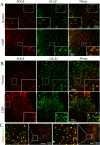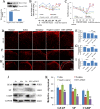Mechanisms of PDGF siRNA-mediated inhibition of bone cancer pain in the spinal cord
- PMID: 27282805
- PMCID: PMC4901320
- DOI: 10.1038/srep27512
Mechanisms of PDGF siRNA-mediated inhibition of bone cancer pain in the spinal cord
Abstract
Patients with tumors that metastasize to bone frequently suffer from debilitating pain, and effective therapies for treating bone cancer are lacking. This study employed a novel strategy in which herpes simplex virus (HSV) carrying a small interfering RNA (siRNA) targeting platelet-derived growth factor (PDGF) was used to alleviate bone cancer pain. HSV carrying PDGF siRNA was established and intrathecally injected into the cavum subarachnoidale of animals suffering from bone cancer pain and animals in the negative group. Sensory function was assessed by measuring thermal and mechanical hyperalgesia. The mechanism by which PDGF regulates pain was also investigated by comparing the differential expression of pPDGFRα/β and phosphorylated ERK and AKT. Thermal and mechanical hyperalgesia developed in the rats with bone cancer pain, and these effects were accompanied by bone destruction in the tibia. Intrathecal injection of PDGF siRNA and morphine reversed thermal and mechanical hyperalgesia in rats with bone cancer pain. In addition, we observed attenuated astrocyte hypertrophy, down-regulated pPDGFRα/β levels, reduced levels of the neurochemical SP, a reduction in CGRP fibers and changes in pERK/ERK and pAKT/AKT ratios. These results demonstrate that PDGF siRNA can effectively treat pain induced by bone cancer by blocking the AKT-ERK signaling pathway.
Figures





Similar articles
-
Reversal of bone cancer pain by HSV-1-mediated silencing of CNTF in an afferent area of the spinal cord associated with AKT-ERK signal inhibition.Curr Gene Ther. 2014;14(5):377-88. doi: 10.2174/156652321405140926162236. Curr Gene Ther. 2014. PMID: 25687503
-
The relationship of bone-tumor-induced spinal cord astrocyte activation and aromatase expression to mechanical hyperalgesia and cold hypersensitivity in intact female and ovariectomized mice.Neuroscience. 2016 Jun 2;324:344-54. doi: 10.1016/j.neuroscience.2016.03.030. Epub 2016 Mar 16. Neuroscience. 2016. PMID: 26995084
-
Blocking EphB1 receptor forward signaling in spinal cord relieves bone cancer pain and rescues analgesic effect of morphine treatment in rodents.Cancer Res. 2011 Jul 1;71(13):4392-402. doi: 10.1158/0008-5472.CAN-10-3870. Epub 2011 May 9. Cancer Res. 2011. PMID: 21555368
-
Minocycline attenuates bone cancer pain in rats by inhibiting NF-κB in spinal astrocytes.Acta Pharmacol Sin. 2016 Jun;37(6):753-62. doi: 10.1038/aps.2016.1. Epub 2016 May 9. Acta Pharmacol Sin. 2016. PMID: 27157092 Free PMC article.
-
Knockdown of PAR2 alleviates cancer-induced bone pain by inhibiting the activation of astrocytes and the ERK pathway.BMC Musculoskelet Disord. 2022 May 30;23(1):514. doi: 10.1186/s12891-022-05312-x. BMC Musculoskelet Disord. 2022. PMID: 35637468 Free PMC article.
Cited by
-
Somatostatin-immunoreactive neurons of the rat gut during the development.Histochem Cell Biol. 2024 Nov;162(5):385-402. doi: 10.1007/s00418-024-02322-9. Epub 2024 Aug 17. Histochem Cell Biol. 2024. PMID: 39153131
-
Amitriptyline influences the mechanical withdrawal threshold in bone cancer pain rats by regulating glutamate transporter GLAST.Mol Pain. 2019 Jan-Dec;15:1744806919855834. doi: 10.1177/1744806919855834. Mol Pain. 2019. PMID: 31218920 Free PMC article.
-
Small non-coding RNAs-based bone regulation and targeting therapeutic strategies.Mol Cell Endocrinol. 2017 Nov 15;456:16-35. doi: 10.1016/j.mce.2016.11.018. Epub 2016 Nov 23. Mol Cell Endocrinol. 2017. PMID: 27888003 Free PMC article. Review.
-
Platelet-derived Growth Factor Receptor-α Induces Contraction Knots and Inflammatory Pain-like Behavior in a Rat Model of Myofascial Trigger Points.Anesthesiology. 2024 Nov 1;141(5):929-945. doi: 10.1097/ALN.0000000000005167. Anesthesiology. 2024. PMID: 39058323 Free PMC article.
-
PDGFBB facilitates tumorigenesis and malignancy of lung adenocarcinoma associated with PI3K-AKT/MAPK signaling.Sci Rep. 2024 Feb 20;14(1):4191. doi: 10.1038/s41598-024-54801-7. Sci Rep. 2024. PMID: 38378786 Free PMC article.
References
-
- Coleman R. E. Skeletal complications of malignancy. Cancer. 80, 1588–1594 (2004). - PubMed
-
- Lipton A. et al. Pamidronate prevents skeletal complications and is effective palliative treatment with breast carcinoma and osteolytic bone metastases: long-term follow-up of two randomized, placebo-controlled trails. Cancer. 88, 1082–1090 (2000). - PubMed
-
- Bernard W. S. & Christopher P. W. The global and regional burden of cancer in World cancer report 2014. (eds Devid F. et al.) 26–27 (International Agency for Research on Cancer, 2014).
-
- Coleman R. E. Clinical features of metastatic bone disease and risk of skeletal morbidity. Clin Cancer Res. 12, 6243s–6249s (2006). - PubMed
-
- Galasko C. S. B. [The anatomy and pathways of skeletal metastases] Bone Metastases [Weiss L. & Gilbert A. (ed.)] [49–63] (Boston, GK Hall, 1981).
Publication types
MeSH terms
Substances
LinkOut - more resources
Full Text Sources
Other Literature Sources
Medical
Research Materials
Miscellaneous

